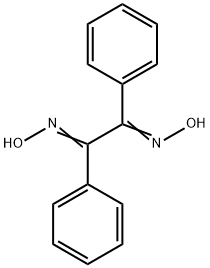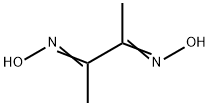DIPHENYLGLYOXIME
Synonym(s):α-Benzil dioxime
- CAS NO.:23873-81-6
- Empirical Formula: C14H12N2O2
- Molecular Weight: 240.26
- MDL number: MFCD00002113
- EINECS: 245-921-0
- SAFETY DATA SHEET (SDS)
- Update Date: 2024-12-18 14:08:52

What is DIPHENYLGLYOXIME?
Chemical properties
yellowish-orange powder
The Uses of DIPHENYLGLYOXIME
anti-Diphenylglyoxime (α-Benzil dioxime) was used as a chelating agent in differential pulse adsorptive stripping voltammetric (DPASV) determination of cobalt in vegetable animal foodstuffs.
Properties of DIPHENYLGLYOXIME
| Melting point: | 237-240 °C (dec.) (lit.) |
| Boiling point: | 382.97°C (rough estimate) |
| Density | 1.1613 (rough estimate) |
| refractive index | 1.6180 (estimate) |
| storage temp. | Inert atmosphere,Room Temperature |
| Water Solubility | Insoluble in water |
| form | powder to crystal |
| pka | 9.70±0.28(Predicted) |
| color | White to Orange to Green |
| Merck | 14,1079 |
| BRN | 2053615 |
| CAS DataBase Reference | 23873-81-6(CAS DataBase Reference) |
| EPA Substance Registry System | Ethanedione, diphenyl-, dioxime (23873-81-6) |
Safety information for DIPHENYLGLYOXIME
| Signal word | Warning |
| Pictogram(s) |
 Exclamation Mark Irritant GHS07 |
| GHS Hazard Statements |
H315:Skin corrosion/irritation H319:Serious eye damage/eye irritation H335:Specific target organ toxicity, single exposure;Respiratory tract irritation |
| Precautionary Statement Codes |
P261:Avoid breathing dust/fume/gas/mist/vapours/spray. P305+P351+P338:IF IN EYES: Rinse cautiously with water for several minutes. Remove contact lenses, if present and easy to do. Continuerinsing. |
Computed Descriptors for DIPHENYLGLYOXIME
| InChIKey | JJZONEUCDUQVGR-WXUKJITCSA-N |
New Products
Tert-butyl bis(2-chloroethyl)carbamate (S)-3-Aminobutanenitrile hydrochloride N-Boc-D-alaninol N-BOC-D/L-ALANINOL 3-(2,4-Dimethoxybenzyl)dihydropyrimidine-2,4(1H,3H)-dione 6-Bromo-3-iodo-1-methyl-1H-indazole 7-Bromo-1H-indazole 3-Morpholino-1-(4-nitrophenyl)-5,6-dihydropyridin- 2(1H)-one Tropic acid Furan-2,5-Dicarboxylic Acid Electrolytic Iron Powder 1,1’-CARBONYLDIIMIDAZOLE R-2-BENZYLOXY PROPIONIC ACID 1,1’-CARBONYLDI (1,2-4 TRIAZOLE) 4-HYDROXY BENZYL ALCOHOL S-2-CHLORO PROPIONIC ACID (2-Hydroxyphenyl)acetonitrile 4-Bromopyrazole 5-BROMO-2CYANO PYRIDINE 5,6-Dimethoxyindanone 5-broMo-2-chloro-N-cyclopentylpyriMidin-4-aMine 4-Ethylbenzylamine N-(5-Amino-2-methylphenyl)acetamide Methyl 5-bromo-2-chloro-3-nitrobenzoateRelated products of tetrahydrofuran








You may like
-
 23873-81-6 Benzildioxime 98%View Details
23873-81-6 Benzildioxime 98%View Details
23873-81-6 -
 Diphenyl glyoxime, GR 99% CAS 23873-81-6View Details
Diphenyl glyoxime, GR 99% CAS 23873-81-6View Details
23873-81-6 -
 Benzil Dioxime CAS 23873-81-6View Details
Benzil Dioxime CAS 23873-81-6View Details
23873-81-6 -
 anti-Diphenylglyoxime CAS 23873-81-6View Details
anti-Diphenylglyoxime CAS 23873-81-6View Details
23873-81-6 -
 1446013-08-6 Fmoc-His-Aib-OH TFA 98%View Details
1446013-08-6 Fmoc-His-Aib-OH TFA 98%View Details
1446013-08-6 -
 127464-43-1 99%View Details
127464-43-1 99%View Details
127464-43-1 -
 2-ETHYLPYRIDINE 100-71-0 99%View Details
2-ETHYLPYRIDINE 100-71-0 99%View Details
100-71-0 -
 13162-05-5 99%View Details
13162-05-5 99%View Details
13162-05-5
Statement: All products displayed on this website are only used for non medical purposes such as industrial applications or scientific research, and cannot be used for clinical diagnosis or treatment of humans or animals. They are not medicinal or edible.